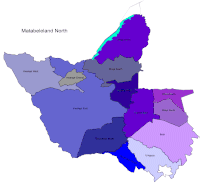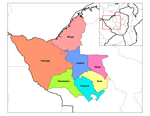Matabeleland North Province
Matabeleland North Province | |
|---|---|
UTC+2 (CEST) | |
| HDI (2021) | 0.541[1] low · 9th of 10 |
Matabeleland North is a province in western Zimbabwe. With a population of 827,645 as of the 2022 census,[2] it is the country's second-least populous province, after Matabeleland South, and is the country's least densely populated province. Matabeleland North and Matabeleland South were established in 1974, when the original Matabeleland Province was bifurcated.[3] In 1997, the province lost territory when the city of Bulawayo became a province in its own right. Matabeleland North is divided into seven districts. Its capital is Lupane, and Victoria Falls and Hwange its largest towns. The name "Matabeleland" is derived from the Matabele or Ndebele people, the province's largest ethnic group.
Matabeleland North is bordered by Matabeleland South and Bulawayo to the south,
Demographics
| Census | Population[2] |
|---|---|
| 2002 | 704,948 |
| 2012 | 749,017 |
| 2022 | 827,645 |
Geography


The region of
The region does have a significant amount of other resources like gold, limestone, methane gas, coal, and timber. As seen in
Government
Districts
Matabeleland North is divided into 7 districts:
- Binga
- Bubi
- Hwange
- Lupane
- Nkayi
- Tsholotsho
- Umguza
Elections
The region is regarded as a very independent region when it comes to politics.
See also
References
- ^ "Sub-national HDI - Area Database - Global Data Lab". hdi.globaldatalab.org. Retrieved 13 September 2018.
- ^ a b "Zimbabwe: Administrative Division (Provinces and Districts) - Population Statistics, Charts and Map". www.citypopulation.de. Retrieved 17 February 2024.
- ^ "Zimbabwe Provinces". www.statoids.com. Retrieved 19 May 2021.
- ^ Zwinoira, Tatira (16 January 2018). "Harare, Byo has lowest economic activity rate". NewsDay Zimbabwe. Retrieved 26 June 2018.
- ^ a b Heinrich Böll Stiftung | Afrika
- ^ C. Michael Hogan (2008) Makgadikgadi, The Megalithic Portal, ed. A. Burnham
- ^ Kubatana - Archive - Results - 'Harmonised' elections 29 March 2008: House of Assembly and Senate Archived 7 April 2008 at the Wayback Machine
